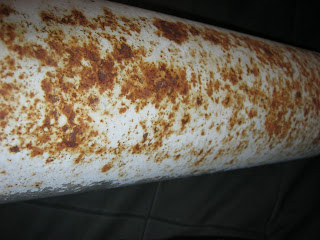The OPTUS "Rat-scope"
Huh?!?! Was it left outside??? I know it was cheap, but not that cheap.
I took it apart, took care of the worst bit of rust, cleaned the mirrors, they show their age but are usable as it turns out. I gave the tube a new paint job, reassembled it and tried it out with some of my microscope eyepieces.
The Optus 76/700 reflector telescope, with a new paint job (and an added "finder" scope)
The (partially dismantled) Alt-Az mount in its full gory glory
Currently I use these three microscope eyepieces:
- A Carl-Zeiss Jena 6,3x (about f = 40 mm, Huygens type) which I use instead of a finder scope and it gives me nice 17x magnification. The eyepiece itself is more a narrow apparent field of view, but with the low magnification this gives me a good wide actual field of view.
- Then I have a LOMO 15x (about f = 17 mm,
HuygensRamsdenSymmetrical type) which is nice and gives me about 42x magnification. The eyepiece has a really wide-field of view and I like it a lot. From what I have gathered, the "symmetrical" type is similar to a "Dial Sight" or a "Plössl". - And finally I have a Linos Spindler Hoyer 25x (f = 10 mm, Orthoscopic type,
AKA "Abbe", which seems to be a well correct "Super Plössl", possibly made by Will, Wetzlar) which is a bit darker, but gives me nice 70x magnification.
[Update] Having tested it now at 70x magnification with the Ortho10mm (and having read Steve Waldee can go with clear skies up to 350x in his similar 3" scope), I can say this scope can probably go to much higher magnifications. [/Update]
During the evening, looking into neighbours windows (about 3/4 of an kilometre away) it works like a charm! And I haven't even collimated it. The screws of the secondary are stuck (but looking through the scope without the eyepiece the position of the secondary seems halfway right). And I haven't taken the time to look up how to properly collimate the primary (the screws for the primary are OK, so I should be able to collimate the primary). The awful azimuthal mount is quite shaky, but the image is really good, considering that is not collimated, and how cheap it was – a real scope of death. :-)
Too bad the night sky is overcast at the moment… I want to look at the Moon first and then in the future maybe some of the deep sky objects. The Orion nebula is not visible this time of year, and I haven't yet looked up where Andromeda is this time of year. And I want to aim it at Mars, Venus, Saturn and Jupiter, possibly all the planets – depending what is visible here. The view of the sky here is a bit limited, so it is a bit of a challenge – but this fits a scope with a shaky mount and no finder scope.
And no matter how bad people think this "little" scope may be, it probably is much better than what Newton or Galileo had… And after all the eyepieces I have are rather good.
I for my part look forward to a bit of skygazing. And the eyepiece position give me a much more relaxed viewing position than my 7x60 binoculars – those turned out to be a flop. The optics of my binos are so-so (and might actually be OK for what I want to do, though the magnification is not enough), the viewing position however is really awful, without some sort of "bino chair"… I can't wait to see something in the sky with my scope!




I have this same scope! Mine is at least 20 years old but was in storage for most of that time, and the mirrors are perfect. I just made a drawing of Mars that might interest you; it's in the update section at the end of my article about drawing Jupiter with my 4.7 inch f/8 refractor:
ReplyDeletehttp://freescruz.com/~4cygni/faintfuzzies.blogspot.com/nice_jupiter_from_home.html
I was using 280x which is about max for the scope for clarity on Mars, given its current angular diameter and my seeing conditions. But, of course, the "rule" says NEVER go more than 50x per inch--or 150x. Sheer nonsense. It depends on the scope; the object you are looking at; your eyes; the alignment of the instrument; and the seeing. Sometimes 50x per inch is too much. I simply experiment.
Steve W.